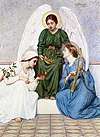Ambrose
Aurelius Ambrosius[lower-alpha 1] (c. 340–397), better known in English as Ambrose (/ˈæmbroʊz/), an Archbishop of Milan, became one of the most influential ecclesiastical figures of the 4th century. He served as the Roman governor of Liguria and Emilia, headquartered in Milan, before popular acclamation propelled him into becoming Bishop of Milan in 374. Ambrose staunchly opposed Arianism.
Saint Ambrose | |
|---|---|
| Archbishop of Milan | |
 Early mosaic of Ambrose that might be an actual portrait. | |
| Archdiocese | Mediolanum |
| See | Mediolanum |
| Appointed | AD 374 |
| Term ended | 4 April 397 |
| Predecessor | Auxentius |
| Successor | Simplician |
| Orders | |
| Consecration | 7 December 374 |
| Personal details | |
| Birth name | Aurelius Ambrosius |
| Born | c. 340 Augusta Treverorum, Gallia Belgica, Roman Empire (now Trier, Germany) |
| Died | 4 April 397 (aged 56–57) Mediolanum, Roman Italy, Roman Empire (now Milan, Italy) |
| Sainthood | |
| Feast day | December 7[1] |
| Venerated in | Catholic Church Eastern Orthodox Church Oriental Orthodoxy Anglican Communion Lutheranism |
| Title as Saint | Confessor and Doctor of the Church |
| Attributes | Beehive, a child, whip, bones |
| Patronage | Bee keepers; bees; bishops; candle makers; domestic animals; French Commissariat; geese; learning; livestock; Milan; police officers; students; wax refiners |
| Shrines | Basilica of Sant'Ambrogio |
Ambrose of Milan | |
|---|---|
| Nationality | Ancient Roman |
Notable work | Veni redemptor gentium |
| Theological work | |
| Tradition or movement | Trinitarianism |
| Main interests | Mariology |
| Notable ideas | Filioque,[2] anti-paganism, mother of the Church[3] |
Western Christianity identified Ambrose as one of its four traditional Doctors of the Church, and as the patron saint of Milan. He had notable influence on Augustine of Hippo (354-430).
Tradition credits Ambrose with promoting "antiphonal chant", a style of chanting in which one side of the choir responds alternately to the other, as well as with composing Veni redemptor gentium, an Advent hymn.
Life
Early life
Ambrose was born into a Roman Christian family about 340 and was raised in Gallia Belgica, the capital of which was Augusta Treverorum.[4] His father is sometimes identified with Aurelius Ambrosius,[5][6] a praetorian prefect of Gaul;[1] but some scholars identify his father as an official named Uranius who received an imperial constitution dated 3 February 339 (addressed in a brief extract from one of the three emperors ruling in 339, Constantine II, Constantius II, or Constans, in the Codex Theodosianus, book XI.5).[7][8][9]
His mother was a woman of intellect and piety[10] and a member of the Roman family Aurelii Symmachi,[11] and thus Ambrose was cousin of the orator Quintus Aurelius Symmachus. He was the youngest of three children, who included Marcellina and Satyrus (who is the subject of Ambrose's De excessu fratris Satyri), also venerated as saints.[12] There is a legend that as an infant, a swarm of bees settled on his face while he lay in his cradle, leaving behind a drop of honey. His father considered this a sign of his future eloquence and honeyed tongue. For this reason, bees and beehives often appear in the saint's symbology.
After the early death of his father, Ambrose went to Rome where he studied literature, law, and rhetoric. He then followed in his father's footsteps and entered public service. Praetorian Prefect Sextus Claudius Petronius Probus first gave him a place in the council and then in about 372 made him governor of Liguria and Emilia, with headquarters at Milan.[1] In 286 Diocletian had moved the capital of the Western Roman Empire from Rome to Mediolanum (Milan).
Ambrose was the Governor of Aemilia-Liguria in northern Italy until 374, when he became the Bishop of Milan. He was a very popular political figure, and since he was the Governor in the effective capital in the Roman West, he was a recognizable figure in the court of Valentinian I.
Bishop of Milan
In the late 4th century there was a deep conflict in the diocese of Milan between the Nicene Church and Arians.[13][14] In 374 the bishop of Milan, Auxentius, an Arian, died, and the Arians challenged the succession. Ambrose went to the church where the election was to take place, to prevent an uproar, which was probable in this crisis. His address was interrupted by a call, "Ambrose, bishop!", which was taken up by the whole assembly.[14]
Ambrose was known to be Nicene Christian in belief, but also acceptable to Arians due to the charity shown in theological matters in this regard. At first he energetically refused the office, for which he was in no way prepared: Ambrose was neither baptized nor formally trained in theology.[1] Upon his appointment, Ambrose fled to a colleague's home seeking to hide. Upon receiving a letter from the Emperor Gratian praising the appropriateness of Rome appointing individuals evidently worthy of holy positions, Ambrose's host gave him up. Within a week, he was baptized, ordained and duly consecrated bishop of Milan.
As bishop, he immediately adopted an ascetic lifestyle, apportioned his money to the poor, donating all of his land, making only provision for his sister Marcellina (who had become a nun). This raised his popularity even further, giving him considerable political leverage over even the emperor. Upon the unexpected appointment of Ambrose to the episcopate, his brother Satyrus resigned a prefecture in order to move to Milan, where he took over managing the family's affairs.[4]
Arianism
.jpg)
Ambrose studied theology with Simplician, a presbyter of Rome.[10] Using to his advantage his excellent knowledge of Greek, which was then rare in the West, he studied the Old Testament and Greek authors like Philo, Origen, Athanasius, and Basil of Caesarea, with whom he was also exchanging letters.[15] He applied this knowledge as preacher, concentrating especially on exegesis of the Old Testament, and his rhetorical abilities impressed Augustine of Hippo, who hitherto had thought poorly of Christian preachers.
In the confrontation with Arians, Ambrose sought to theologically refute their propositions, which were contrary to the Nicene creed and thus to the officially defined orthodoxy. The Arians appealed to many high level leaders and clergy in both the Western and Eastern empires. Although the western Emperor Gratian supported orthodoxy, the younger Valentinian II, who became his colleague in the Empire, adhered to the Arian creed.[16] Ambrose did not sway the young prince's position. In the East, Emperor Theodosius I likewise professed the Nicene creed; but there were many adherents of Arianism throughout his dominions,[10] especially among the higher clergy.
In this contested state of religious opinion, two leaders of the Arians, bishops Palladius of Ratiaria and Secundianus of Singidunum, confident of numbers, prevailed upon Gratian to call a general council from all parts of the empire. This request appeared so equitable that he complied without hesitation. However, Ambrose feared the consequences and prevailed upon the emperor to have the matter determined by a council of the Western bishops. Accordingly, a synod composed of thirty-two bishops was held at Aquileia in the year 381. Ambrose was elected president and Palladius, being called upon to defend his opinions, declined. A vote was then taken and Palladius and his associate Secundianus were deposed from their episcopal offices.[10]
Nevertheless, the increasing strength of the Arians proved a formidable task for Ambrose. In 385[16] or 386 the emperor and his mother Justina, along with a considerable number of clergy and laity, especially military, professed Arianism. They demanded two churches in Milan, one in the city (the Basilica of the Apostles), the other in the suburbs (St Victor's), be allocated to the Arians.[16] Ambrose refused and was required to answer for his conduct before the council.[1] He went, his eloquence in defense of the Church reportedly overawing the ministers of Valentinian, so he was permitted to retire without making the surrender of the churches. The day following, when he was performing divine service in the basilica, the prefect of the city came to persuade him to give up at least the Portian basilica in the suburbs. As he still refused, certain deans or officers of the court were sent to take possession of the Portian basilica, by hanging up in it imperial escutcheons[16] to prepare for the arrival of the emperor and his mother at the ensuing festival of Easter.[17]
In spite of Imperial opposition, Ambrose declared, "If you demand my person, I am ready to submit: carry me to prison or to death, I will not resist; but I will never betray the church of Christ. I will not call upon the people to succour me; I will die at the foot of the altar rather than desert it. The tumult of the people I will not encourage: but God alone can appease it."[17]
In 386 Justina and Valentinian received the Arian bishop Auxentius the younger, and Ambrose was again ordered to hand over a church in Milan for Arian usage. Ambrose and his congregation barricaded themselves inside the church, and the imperial order was rescinded.[18]
Imperial relations

The imperial court was displeased with the religious principles of Ambrose, however his aid was soon solicited by the Emperor. When Magnus Maximus usurped the supreme power in Gaul, and was meditating a descent upon Italy, Valentinian sent Ambrose to dissuade him from the undertaking, and the embassy was successful.[17]
A second later embassy was unsuccessful. The enemy entered Italy and Milan was taken. Justina and her son fled but Ambrose remained at his post and did good service to many of the sufferers by causing the plate of the church to be melted for their relief.[17]
Theodosius I, the emperor of the East, espoused the cause of Justina, and regained the kingdom. Theodosius was excommunicated by Ambrose for the massacre of 7,000 people at Thessalonica in 390,[17] after the murder of the Roman governor there by rioters.[1] Ambrose told Theodosius to imitate David in his repentance as he had imitated him in guilt,[17] and he readmitted the emperor to the Eucharist only after several months of penance. This shows the strong position of a bishop in the western part of the empire, even when facing a strong emperor. The controversy of John Chrysostom with a much weaker emperor a few years later in Constantinople led to a crushing defeat of the bishop.
In 392, after the death of Valentinian II and the fall of Eugenius, Ambrose supplicated the emperor for the pardon of those who had supported Eugenius after Theodosius was eventually victorious.[17]
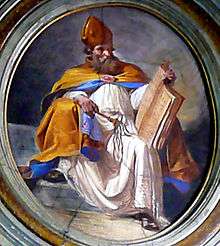
Attitude towards Jews
In his treatise on Abraham, Ambrose warns against intermarriage with pagans, Jews, or heretics.[19] In 388, Emperor Theodosius the Great was informed that a crowd of Christians, led by their bishop, had destroyed the synagogue at Callinicum on the Euphrates. He ordered the synagogue rebuilt at the expense of the bishop,[20] but Ambrose persuaded Theodosius to retreat from this position.[21] He wrote to the Emperor, pointing out that he was thereby "exposing the bishop to the danger of either acting against the truth or of death"; in the letter "the reasons given for the imperial rescript are met, especially by the plea that the Jews had burnt many churches".[22] Ambrose, referring to a prior incident where Magnus Maximus issued an edict censuring Christians in Rome for burning down a Jewish synagogue, warned Theodosius that the people in turn exclaimed "the emperor has become a Jew", implying that if Theodosius attempted to apply the law to protect his Jewish subjects he'd be viewed similarly.[23] In the course of the letter Ambrose speaks of the clemency that the emperor had shown with regard to the many houses of wealthy people and churches that had been destroyed by unruly mobs, with many then still not restored and then adds: "There is, then, no adequate cause for such a commotion, that the people should be so severely punished for the burning of a building, and much less since it is the burning of a synagogue, a home of unbelief, a house of impiety, a receptacle of folly, which God Himself has condemned. For thus we read, where the Lord our God speaks by the mouth of the prophet Jeremiah: 'And I will do to this house, which is called by My Name, wherein ye trust, and to the place which I gave to you and to your fathers, as I have done to Shiloh, and I will cast you forth from My sight, as I cast forth your brethren, the whole seed of Ephraim. And do not thou pray for that people, and do not thou ask mercy for them, and do not come near Me on their behalf, for I will not hear thee. Or seest thou not what they do in the cities of Judah?'[Jeremiah 7:14] God forbids intercession to be made for those."[22][24] Yet, Ambrose did not oppose punishing those who were directly responsible for destroying the synagogue.
In his exposition of Psalm 1, Ambrose says: "Virtues without faith are leaves, flourishing in appearance, but unproductive. How many pagans have mercy and sobriety but no fruit, because they do not attain their purpose! The leaves speedily fall at the wind's breath. Some Jews exhibit purity of life and much diligence and love of study, but bear no fruit and live like leaves."[25]
Attitude towards pagans
Under his influence, emperors Gratian, Valentinian II and Theodosius I carried on a persecution of paganism;[26][lower-alpha 2][28][29] Theodosius issued the 391 "Theodosian decrees," which with increasing intensity outlawed pagan practices.[27][30]The Altar of Victory was removed by Gratian. Ambrose prevailed upon Gratian, Valentinian and Theodosius to reject requests to restore the altar.
Later years and death
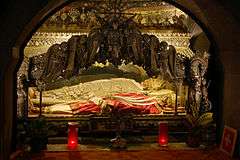
In April 393 Arbogast, magister militum of the West and his puppet Emperor Eugenius, marched into Italy to consolidate their position in regard to Theodosius I and his son, Honorius, whom Theodosius had appointed Augustus to govern the western portion of the empire. Arbogast and Eugenius courted Ambrose's support by very obliging letters; but before they arrived at Milan, he had retired to Bologna, where he assisted at the translation of the relics of Saints Vitalis and Agricola. From there he went to Florence, where he remained until Eugenius withdrew from Milan to meet Theodosius in the Battle of the Frigidus in early September 394.[31]
Soon after acquiring the undisputed possession of the Roman Empire, Theodosius died at Milan in 395, and two years later (4 April 397) Ambrose also died. He was succeeded as bishop of Milan by Simplician.[17] Ambrose's body may still be viewed in the church of Saint Ambrogio in Milan, where it has been continuously venerated – along with the bodies identified in his time as being those of Saints Gervase and Protase.
Character
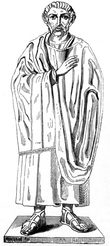
Many circumstances in the history of Ambrose are characteristic of the general spirit of the times. The chief causes of his victory over his opponents were his great popularity and the reverence paid to the episcopal character at that period. He used several indirect means to obtain and support his authority with the people.[17]
It was his custom to comment severely in his preaching on the public characters of his times; and he introduced popular reforms in the order and manner of public worship. It is alleged, too, that at a time when the influence of Ambrose required vigorous support, he was admonished in a dream to search for, and found under the pavement of the church, the remains of two martyrs, Gervasius and Protasius. The saints, although they would have had to have been hundreds of years old, looked as if they had just died. The applause of the people was mingled with the derision of the court party.[17]
Theology
Ambrose joins Augustine, Jerome, and Gregory the Great as one of the Latin Doctors of the Church. Theologians compare him with Hilary, who they claim fell short of Ambrose's administrative excellence but demonstrated greater theological ability. He succeeded as a theologian despite his juridical training and his comparatively late handling of Biblical and doctrinal subjects.[17]
Ambrose's intense episcopal consciousness furthered the growing doctrine of the Church and its sacerdotal ministry, while the prevalent asceticism of the day, continuing the Stoic and Ciceronian training of his youth, enabled him to promulgate a lofty standard of Christian ethics. Thus we have the De officiis ministrorum, De viduis, De virginitate and De paenitentia.[17]
Ambrose displayed a kind of liturgical flexibility that kept in mind that liturgy was a tool to serve people in worshiping God, and ought not to become a rigid entity that is invariable from place to place. His advice to Augustine of Hippo on this point was to follow local liturgical custom. "When I am at Rome, I fast on a Saturday; when I am at Milan, I do not. Follow the custom of the church where you are."[32][33] Thus Ambrose refused to be drawn into a false conflict over which particular local church had the "right" liturgical form where there was no substantial problem. His advice has remained in the English language as the saying, "When in Rome, do as the Romans do."
One interpretation of Ambrose's writings is that he was a Christian universalist.[34] It has been noted that Ambrose's theology was significantly influenced by that of Origen and Didymus the Blind, two other early Christian universalists.[34] One quotation cited in favor of this belief is:
Our Savior has appointed two kinds of resurrection in the Apocalypse. 'Blessed is he that hath part in the first resurrection,' for such come to grace without the judgment. As for those who do not come to the first, but are reserved unto the second resurrection, these shall be disciplined until their appointed times, between the first and the second resurrection.[35]
One could interpret this passage as being another example of the mainstream Christian belief in a general resurrection (that both those in heaven and in hell undergo a bodily resurrection), or an allusion to purgatory (that some destined for heaven must first undergo a phase of purification). Several other works by Ambrose clearly teach the mainstream view of salvation. For example: "The Jews feared to believe in manhood taken up into God, and therefore have lost the grace of redemption, because they reject that on which salvation depends."[36]
Giving to the poor
He was also interested in the condition of contemporary Italian society.[37] Ambrose considered the poor not a distinct group of outsiders, but a part of the united, solidary people. Giving to the poor was not to be considered an act of generosity towards the fringes of society but a repayment of resources that God had originally bestowed on everyone equally and that the rich had usurped.[38]
Mariology
The theological treatises of Ambrose of Milan would come to influence Popes Damasus, Siricius and Leo XIII. Central to Ambrose is the virginity of Mary and her role as Mother of God.[39]
- The virgin birth is worthy of God. Which human birth would have been more worthy of God, than the one in which the Immaculate Son of God maintained the purity of his immaculate origin while becoming human?[40]
- We confess that Christ the Lord was born from a virgin, and therefore we reject the natural order of things. Because she conceived not from a man but from the Holy Spirit.[41]
- Christ is not divided but one. If we adore him as the Son of God, we do not deny his birth from the virgin. ... But nobody shall extend this to Mary. Mary was the temple of God but not God in the temple. Therefore, only the one who was in the temple can be worshiped.[42]
- Yes, truly blessed for having surpassed the priest (Zechariah). While the priest denied, the Virgin rectified the error. No wonder that the Lord, wishing to rescue the world, began his work with Mary. Thus she, through whom salvation was being prepared for all people, would be the first to receive the promised fruit of salvation.[43]
Ambrose viewed celibacy as superior to marriage and saw Mary as the model of virginity.[44]
Writings
| Part of a series on |
| Catholic philosophy |
|---|
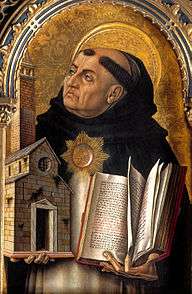  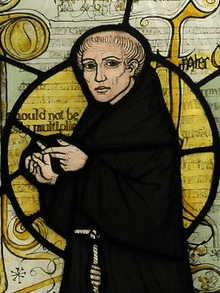 |
| Ethics |
|
| Schools |
|
| Philosophers |
|
Postclassical
|
|
Modern
|
|
Contemporary
|
|
|
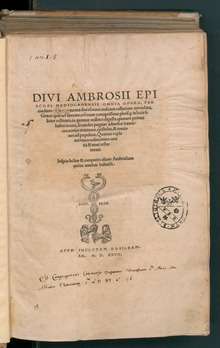
In matters of exegesis he is, like Hilary, an Alexandrian. In dogma he follows Basil of Caesarea and other Greek authors, but nevertheless gives a distinctly Western cast to the speculations of which he treats. This is particularly manifest in the weightier emphasis which he lays upon human sin and divine grace, and in the place which he assigns to faith in the individual Christian life.[17]
- De fide ad Gratianum Augustum (On Faith, to Gratian Augustus)
- De Officiis Ministrorum (On the Offices of Ministers, an ecclesiastical handbook modeled on Cicero's De Officiis.[45])
- De Spiritu Sancto (On the Holy Ghost)
- De incarnationis Dominicae sacramento (On the Sacrament of the Incarnation of the Lord)
- De mysteriis (On the Mysteries)
- Expositio evangelii secundum Lucam (Commentary on the Gospel according to Luke)
- Ethical works: De bono mortis (Death as a Good); De fuga saeculi (Flight From the World); De institutione virginis et sanctae Mariae virginitate perpetua ad Eusebium (On the Birth of the Virgin and the Perpetual Virginity of Mary); De Nabuthae (On Naboth); De paenitentia (On Repentance); De paradiso (On Paradise); De sacramentis (On the Sacraments); De viduis (On Widows); De virginibus (On Virgins); De virginitate (On Virginity); Exhortatio virginitatis (Exhortation to Virginity); De sacramento regenerationis sive de philosophia (On the Sacrament of Rebirth, or, On Philosophy [fragments])
- Homiletic commentaries on the Old Testament: the Hexaemeron (Six Days of Creation); De Helia et ieiunio (On Elijah and Fasting); De Iacob et vita beata (On Jacob and the Happy Life); De Abraham; De Cain et Abel; De Ioseph (Joseph); De Isaac vel anima (On Isaac, or The Soul); De Noe (Noah); De interpellatione Iob et David (On the Prayer of Job and David); De patriarchis (On the Patriarchs); De Tobia (Tobit); Explanatio psalmorum (Explanation of the Psalms); Explanatio symboli (Commentary on the Symbol).
- De obitu Theodosii; De obitu Valentiniani; De excessu fratris Satyri (funeral orations)
- 91 letters
- A collection of hymns on the Creation of the Universe.
- Fragments of sermons
- Ambrosiaster or the "pseudo-Ambrose" is a brief commentary on Paul's Epistles, which was long attributed to Ambrose.
 Stained-glass window by Sergio de Castro based on the Ambrosian hymns about the Creation of the universe, Church of the Benedictines at Couvrechef – La Folie (Caen), 1956–59.
Stained-glass window by Sergio de Castro based on the Ambrosian hymns about the Creation of the universe, Church of the Benedictines at Couvrechef – La Folie (Caen), 1956–59. Detail of the Seventh Day of Creation: divine rest with the Ambrosian hymns.
Detail of the Seventh Day of Creation: divine rest with the Ambrosian hymns.
Church music
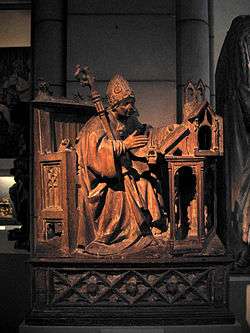
Ambrose is traditionally credited but not actually known to have composed any of the repertory of Ambrosian chant also known simply as "antiphonal chant", a method of chanting where one side of the choir alternately responds to the other. (The later pope Gregory I the Great is not known to have composed any Gregorian chant, the plainsong or "Romish chant".) However, Ambrosian chant was named in his honor due to his contributions to the music of the Church; he is credited with introducing hymnody from the Eastern Church into the West.
Catching the impulse from Hilary of Arles and confirmed in it by the success of Arian psalmody, Ambrose composed several original hymns as well, four of which still survive, along with music which may not have changed too much from the original melodies. Each of these hymns has eight, four-line stanzas and is written in strict iambic tetrameter (that is 4 x 2 syllables, each iamb being two syllables). Marked by dignified simplicity, they served as a fruitful model for later times.[17]
- Deus Creator Omnium
- Aeterne rerum conditor
- Jam surgit hora tertia
- Jam Christus astra ascenderat
- Veni redemptor gentium (a Christmas hymn)[17]
In his writings, Ambrose refers only to the performance of psalms, in which solo singing of psalm verses alternated with a congregational refrain called an antiphon.
Saint Ambrose was also traditionally credited with composing the hymn "Te Deum", which he is said to have composed when he baptised Saint Augustine of Hippo, his celebrated convert.
Augustine
Ambrose was Bishop of Milan at the time of Augustine's conversion, and is mentioned in Augustine's Confessions. It is commonly understood in the Christian Tradition that Ambrose baptized Augustine.
In a passage of Augustine's Confessions in which Augustine wonders why he could not share his burden with Ambrose, he comments: "Ambrose himself I esteemed a happy man, as the world counted happiness, because great personages held him in honor. Only his celibacy appeared to me a painful burden."[46]
Reading
In this same passage of Augustine's Confessions is an anecdote which bears on the history of reading:
When [Ambrose] read, his eyes scanned the page and his heart sought out the meaning, but his voice was silent and his tongue was still. Anyone could approach him freely and guests were not commonly announced, so that often, when we came to visit him, we found him reading like this in silence, for he never read aloud.[46]
This is a celebrated passage in modern scholarly discussion. The practice of reading to oneself without vocalizing the text was less common in antiquity than it has since become. In a culture that set a high value on oratory and public performances of all kinds, in which the production of books was very labor-intensive, the majority of the population was illiterate, and where those with the leisure to enjoy literary works also had slaves to read for them, written texts were more likely to be seen as scripts for recitation than as vehicles of silent reflection. However, there is also evidence that silent reading did occur in antiquity and that it was not generally regarded as unusual.[47][48][49]
Bibliography
Latin
- Hexameron, De paradiso, De Cain, De Noe, De Abraham, De Isaac, De bono mortis – ed. C. Schenkl 1896, Vol. 32/1 (In Latin)
- De Iacob, De Ioseph, De patriarchis, De fuga saeculi, De interpellatione Iob et David, De apologia prophetae David, De Helia, De Nabuthae, De Tobia – ed. C. Schenkl 1897, Vol. 32/2
- Expositio evangelii secundum Lucam – ed. C. Schenkl 1902, Vol. 32/4
- Expositio de psalmo CXVIII – ed. M. Petschenig 1913, Vol. 62; editio altera supplementis aucta – cur. M. Zelzer 1999
- Explanatio super psalmos XII – ed. M. Petschenig 1919, Vol. 64; editio altera supplementis aucta – cur. M. Zelzer 1999
- Explanatio symboli, De sacramentis, De mysteriis, De paenitentia, De excessu fratris Satyri, De obitu Valentiniani, De obitu Theodosii – ed. Otto Faller 1955, Vol. 73
- De fide ad Gratianum Augustum – ed. Otto Faller 1962, Vol. 78
- De spiritu sancto, De incarnationis dominicae sacramento – ed. Otto Faller 1964, Vol. 79
- Epistulae et acta – ed. Otto Faller (Vol. 82/1: lib. 1–6, 1968); Otto Faller, M. Zelzer ( Vol. 82/2: lib. 7–9, 1982); M. Zelzer ( Vol. 82/3: lib. 10, epp. extra collectionem. gesta concilii Aquileiensis, 1990); Indices et addenda – comp. M. Zelzer, 1996, Vol. 82/4
English translations
- H. Wace and P. Schaff, eds, A Select Library of Nicene and Post–Nicene Fathers of the Christian Church, 2nd ser., x [Contains translations of De Officiis (under the title De Officiis Ministrorum), De Spiritu Sancto (On the Holy Spirit), De excessu fratris Satyri (On the Decease of His Brother Satyrus), Exposition of the Christian Faith, De mysteriis (Concerning Mysteries), De paenitentia (Concerning Repentance), De virginibus (Concerning Virgins), De viduis (Concerning Widows), and a selection of letters]
- St. Ambrose "On the mysteries" and the treatise on the sacraments by an unknown author, translated by T Thompson, (London: SPCK, 1919) [translations of De sacramentis and De mysteriis; rev edn published 1950]
- S. Ambrosii De Nabuthae: a commentary, translated by Martin McGuire, (Washington, DC: The Catholic University of America, 1927) [translation of On Naboth]
- S. Ambrosii De Helia et ieiunio: a commentary, with an introduction and translation, Sister Mary Joseph Aloysius Buck, (Washington, DC: The Catholic University of America, 1929) [translation of On Elijah and Fasting]
- S. Ambrosii De Tobia: a commentary, with an introduction and translation, Lois Miles Zucker, (Washington, DC: The Catholic University of America, 1933) [translation of On Tobit]
- Funeral orations, translated by LP McCauley et al., Fathers of the Church vol 22, (New York: Fathers of the Church, Inc., 1953) [by Gregory of Nazianzus and Ambrose],
- Letters, translated by Mary Melchior Beyenka, Fathers of the Church, vol 26, (Washington, DC: Catholic University of America, 1954) [Translation of letters 1–91]
- Saint Ambrose on the sacraments, edited by Henry Chadwick, Studies in Eucharistic faith and practice 5, (London: AR Mowbray, 1960)
- Hexameron, Paradise, and Cain and Abel, translated by John J Savage, Fathers of the Church, vol 42, (New York: Fathers of the Church, 1961) [contains translations of Hexameron, De paradise, and De Cain et Abel]
- Saint Ambrose: theological and dogmatic works, translated by Roy J. Deferrari, Fathers of the church vol 44, (Washington: Catholic University of American Press, 1963) [Contains translations of The mysteries, (De mysteriis) The holy spirit, (De Spiritu Sancto), The sacrament of the incarnation of Our Lord, (De incarnationis Dominicae sacramento), and The sacraments]
- Seven exegetical works, translated by Michael McHugh, Fathers of the Church, vol 65, (Washington: Catholic University of America Press, 1972) [Contains translations of Isaac, or the soul, (De Isaac vel anima), Death as a good, (De bono mortis), Jacob and the happy life, (De Iacob et vita beata), Joseph, (De Ioseph), The patriarchs, (De patriarchis), Flight from the world, (De fuga saeculi), The prayer of Job and David, (De interpellatione Iob et David).]
- Homilies of Saint Ambrose on Psalm 118, translated by Íde Ní Riain, (Dublin: Halcyon Press, 1998) [translation of part of Explanatio psalmorum]
- Ambrosian hymns, translated by Charles Kraszewski, (Lehman, PA: Libella Veritatis, 1999)
- Commentary of Saint Ambrose on twelve psalms, translated by Íde M. Ní Riain, (Dublin: Halcyon Press, 2000) [translations of Explanatio psalmorum on Psalms 1, 35–40, 43, 45, 47–49]
- On Abraham, translated by Theodosia Tomkinson, (Etna, CA: Center for Traditionalist Orthodox Studies, 2000) [translation of De Abraham]
- De officiis, edited with an introduction, translation, and commentary by Ivor J Davidson, 2 vols, (Oxford: OUP, 2001) [contains both Latin and English text]
- Commentary of Saint Ambrose on the Gospel according to Saint Luke, translated by Íde M. Ní Riain, (Dublin: Halcyon, 2001) [translation of Expositio evangelii secundum Lucam]
- Ambrose of Milan: political letters and speeches, translated with an introduction and notes by JHWG Liebschuetz, (Liverpool: Liverpool University Press, 2005) [contains Book Ten of Ambrose's Letters, including the oration on the death of Theodosius I; Letters outside the Collection (Epistulae extra collectionem); Letter 30 to Magnus Maximus; The oration on the death of Valentinian II (De obitu Valentiniani).]
Several of Ambrose's works have recently been published in the bilingual Latin-German Fontes Christiani series (currently edited by Brepols).
Several religious brotherhoods which have sprung up in and around Milan at various times since the 14th century have been called Ambrosians. Their connection to Ambrose is tenuous
See also
- Ambrosian hymnography
- Ambrosian Liturgy and Rite
- Saint Ambrose Basilica, Milan
- Church Fathers
- St. Ambrose Cathedral, Linares
- Saint Ambrose, patron saint archive
- Saint Ambrose University, Davenport, Iowa
- Ambrose University College, Calgary, Alberta
References
Notes
- Italian: Sant'Ambrogio [ˌsantamˈbrɔːdʒo]; Lombard: Sant Ambroeus [ˌsãːt ãˈbrøːs].
- 'The law of June 391, issued by Theodosius [...] was issued from Milan and represented the will of its bishop, Ambrose; for Theodosius – recently excommunicated by Ambrose, penitent, and very much under his influence43 – was no natural zealot. Ambrose, on the other hand, was very much a Christian. His restless and imperious ambition for the church's growth, come what might for the non-Christians, is suggested by his preaching'. See also MacMullen 1984, p. 163, note 43, with references to Palanque (1933), Gaudemet (1972), Matthews (1975) and King (1961)[27]
Citations
- Attwater & John 1993.
- Siecienski 2010, p. 57.
- Sharkey & Weinandy 2009, p. 208.
- Loughlin 1907.
- Greenslade 1956, p. 175.
- Paredi & Costelloe 1964, p. 380: "S. Paulinus in Vit. Ambr. 3 has the following: posito in administratione praefecturae Galliarum patre eius Ambrosio natus est Ambrosius. From this, practically all of Ambrose's biographers have concluded that Ambrose's father was praetorian prefect in Gaul. This is the only evidence we have, however, that there ever was an Ambrose as prefect in Gaul."
- Barnes 2011, pp. 45-46.
- Mazzarino, S. "Il padre di Ambrogio", Helikon 13–14, 1973–1974, 111–117.
- Mazzarino, S., "Storia sociale del vescovo Ambrogio", Problemi e ricerche di storia antica 4, Rome 1989, 79–81.
- Grieve 1911, p. 798.
- Barnes 2011, p. 50.
- Santi Beati (in Italian), Italy
- Wilken 2003, p. 218.
- Butler 1991, p. 407.
- Schaff (ed.), Letter of Basil to Ambrose, Christian Classics Ethereal library, retrieved 8 December 2012
- Butler 1991, p. 408.
- Grieve 1911, p. 799.
- The Cambridge Ancient History, p. 106
- De Abraham, ix. 84, xiv. 451
- Lee 2013, p. 41.
- MacCulloch 2010, p. 300.
- "NPNF2-10. Ambrose: Selected Works and Letters - Christian Classics Ethereal Library". www.ccel.org. Retrieved 10 June 2019.
- Nirenberg 2013, pp. 117-118.
- "Council of Centers on Jewish–Christian Relations, "Ambrose of Milan, 'Letters about a Synagogue Burning' (August 388)"". Archived from the original on 27 September 2013. Retrieved 24 September 2013.
- Ambrose, Enarrationes in XII Psalmos Davidicos, "In Psalmum Primum Enarratio", coll. 987–988
- Byfield 2003, p. 92.
- MacMullen 1984, p. 100.
- Roldanus (2006) p. 148
- Hellemo (1989) p. 254
- King 1961, p. 78.
- "Saint Ambrose, Bishop and Confessor, Doctor of the Church. December 7. Rev. Alban Butler. 1866. Volume XII: December. The Lives of the Saints". www.bartleby.com. Retrieved 10 June 2019.
- Augustine of Hippo, Epistle to Januarius, II, section 18
- Augustine of Hippo, Epistle to Casualanus, XXXVI, section 32
- Hanson, JW (1899), "18. Additional Authorities", Universalism: The Prevailing Doctrine of The Christian Church During Its First Five Hundred Years, Boston and Chicago: Universalist Publishing House, archived from the original on 12 May 2013, retrieved 8 December 2012
- The Church Fathers on Universalism, Tentmaker, retrieved 5 December 2007
- Ambrose (1907), "Exposition of the Christian Faith, Book III", The Catholic Encyclopedia, New York: Robert Appleton Co, retrieved 24 February 2009 from New Advent.
- Wojcieszak 2014, pp. 177-187.
- Brown 2012, p. 133.
- "St. Ambrose", Catholic Communications, Sydney Archdiocese
- Ambrose of Milan CSEL 64, 139
- Ambrose of Milan, De Mysteriis, 59, pp. 16, 410
- "NPNF2-10. Ambrose: Selected Works and Letters - Christian Classics Ethereal Library". www.ccel.org. Retrieved 10 June 2019.
- Ambrose of Milan, Expositio in Lucam 2, 17; PL 15, 1640
- De virginibus (On Virgins); De virginitate
- Tierney, Brian; Painter, Sidney (1978). "The Christian Church". Western Europe in the Middle Ages, 300–1475 (3rd ed.). New York, NY: Alfred A Knopf. p. 35. ISBN 978-0-394-32180-6.
- Augustine. Confessions Book Six, Chapter Three.
- Fenton, James (28 July 2006). "Read my lips". The Guardian. London.
- Gavrilov, AK (1997), "Techniques of Reading in Classical Antiquity", Classical Quarterly, 47 (1): 56–73, esp. 70–71, doi:10.1093/cq/47.1.56, JSTOR 639597
- Burnyeat, MF (1997), "Postscript on silent reading", Classical Quarterly, 47 (1): 74–76, doi:10.1093/cq/47.1.74, JSTOR 639598
Works cited
- Attwater, Donald; John, Catherine Rachel (1993), The Penguin Dictionary of Saints (3rd ed.), New York: Penguin Books, ISBN 978-0-14-051312-7
- Barnes, T. D. (2011). "The Election of Ambrose of Milan". In Leemans, Johan; Nuffelen, Peter Van; Keough, Shawn W.J.; Nicolaye, Carla (eds.). Episcopal Elections in Late Antiquity. Walter de Gruyter. ISBN 978-3110268607.CS1 maint: ref=harv (link)
- Brown, Peter (2012). Through the Eye of a Needle: Wealth, the Fall of Rome, and the Making of Christianity in the West, 350-550 AD. Princeton University Press. ISBN 0-691-15290-X.CS1 maint: ref=harv (link)
- Butler (1991), Walsh, Michael (ed.), Lives of the Saints, New York: HarperCollins Publishers
- Byfield, Ted (2003). Darkness Descends : A.D. 350 to 565, the Fall of the Western Roman Empire. Christian History Project. ISBN 978-0-9689873-3-9.CS1 maint: ref=harv (link)
- Deferrari, Roy J., ed. (1954–72), The Fathers of the Church, 26, 42, 44, 65, New York: Fathers of the Church
- Dudden, F. Homes (1935), The Life and Times of St. Ambrose, Oxford: Clarendon Press
- Gilliard, Frank D. (1984), "Senatorial Bishops in the Fourth Century", Harvard Theological Review, 77 (2): 153–175, doi:10.1017/s0017816000014279
- Greenslade, Stanley Lawrence (1956). Early Latin theology: selections from Tertullian, Cyprian, Ambrose, and Jerome. Library of Christian classics. Volume 5. Westminster Press.CS1 maint: ref=harv (link)
- Grieve, Alexander J. (1911). . In Chisholm, Hugh (ed.). Encyclopædia Britannica. 1 (11th ed.). Cambridge University Press. pp. 798–799.CS1 maint: ref=harv (link)
- King, N.Q. (1960), The Emperor Theodosius and the Establishment of Christianity, Philadelphia: Westminster Press
- Lee, A. D. (2013). From Rome to Byzantium AD 363 to 565. Edinburgh University Press. ISBN 978-0-7486-6835-9.CS1 maint: ref=harv (link)
- Loughlin, James (1907). . In Herbermann, Charles (ed.). Catholic Encyclopedia. 1. New York: Robert Appleton Company.CS1 maint: ref=harv (link)
- MacCulloch, Diarmaid (2010). Christianity: The First Three Thousand Years. Penguin. ISBN 978-1-101-18999-3.CS1 maint: ref=harv (link)
- MacMullen, Ramsay (1984). Christianizing the Roman Empire: (A.D. 100-400). Yale University Press. ISBN 978-0-300-03642-8.CS1 maint: ref=harv (link)
- McLynn, Neil B. (1994), Ambrose of Milan: Church and Court in a Christian Capital, The Transformation of the Classical Heritage, 22, Berkeley: University of California Press
- Nirenberg, David (2013). Anti-Judaism: The Western Tradition. Head of Zeus. ISBN 978-1-78185-296-5.CS1 maint: ref=harv (link)
- Paredi, Angelo (1964), Saint Ambrose: His Life and Times, translated by Joseph Costelloe, Notre Dame, IN: University of Notre Dame PressCS1 maint: ref=harv (link)
- Paulinus (1952), Life of St. Ambrose by Paulinus., translated by John A. Lacy, New York: Fathers of the Church
- Sharkey, Michael; Weinandy, Thomas, eds. (1 January 2009). International Theological Commission. Vol II: Texts and Documents, 1986-2007. Ignatius Press. ISBN 978-1-58617-226-8.CS1 maint: ref=harv (link)
- Siecienski, A. Edward (2010). The Filioque: History of a Doctrinal Controversy. OUP USA. ISBN 978-0-19-537204-5.CS1 maint: ref=harv (link)
- von Campenhausen, Hans; Hoffman, Manfred, trans. (1964), Men Who Shaped the Western Church, New York: Harper and Row
- Wilken, Robert Louis (2003). The Spirit of Early Christian Thought: Seeking the Face of God. Yale University Press. ISBN 978-0-300-10598-8.CS1 maint: ref=harv (link)
- Wojcieszak, Maciej (2014). "Obraz społeczeństwa Italii w listach Ambrożego z Mediolanu" [Social issues in the letters of St. Ambrose of Milan]. Christianitas Antiqua (in Polish). 6: 177–187. ISSN 1730-3788.CS1 maint: ref=harv (link)
- "Ambrose", Patron Saints Index, SPQN, January 2009, retrieved 8 December 2012
External links
| Wikimedia Commons has media related to Ambrose. |
| Wikiquote has quotations related to: Ambrose |
- Works by Ambrose at Project Gutenberg
- Works by or about Ambrose at Internet Archive
- Works by Ambrose at LibriVox (public domain audiobooks)

- Christian Classics Ethereal Library, Works of Ambrose of Milan
- Hymni Ambrosii (Latin)
- EarlyChurch.org.uk Extensive bibliography
- Ambrose's works: text, concordances and frequency list
- Ambrose at The Online Library of Liberty
- Opera Omnia
- Ambrose in Anglo-Saxon England, with Pseudo-Ambrose and Ambrosiaster, Contributions to Sources of Anglo-Saxon Literary Culture, by Dabney Anderson Bankert, Jessica Wegmann, and Charles D. Wright.
- "Saint Ambrose" at the Christian Iconography website
- Forum about the "ambrosian rite" (in Italian)
- "Of St. Ambrose" from the Caxton translation of the Golden Legend
- Augustine's account of the penitence of Theodosius
| Catholic Church titles | ||
|---|---|---|
| Preceded by Auxentius |
Archbishop of Milan 374–397 |
Succeeded by Simplician |
